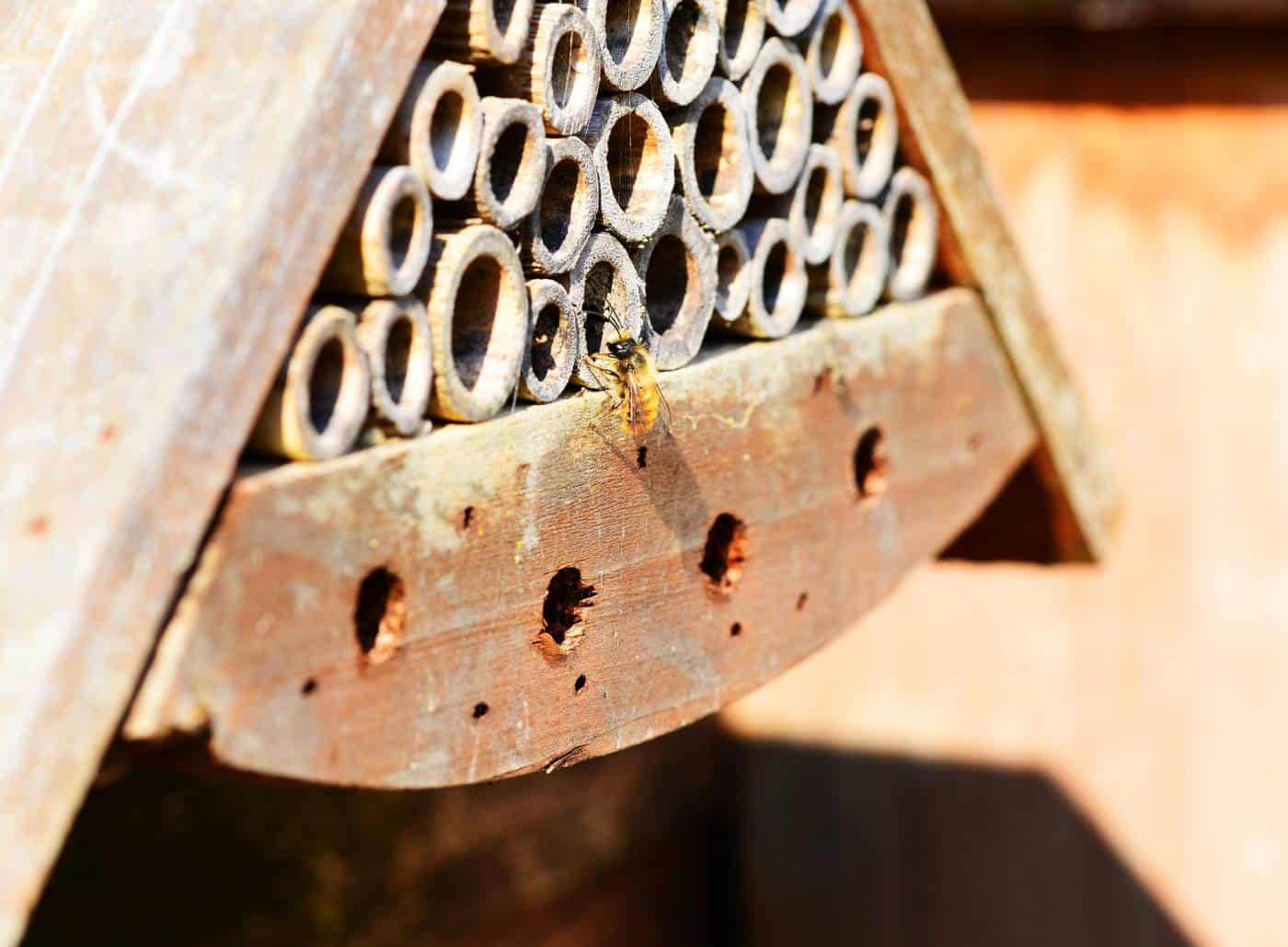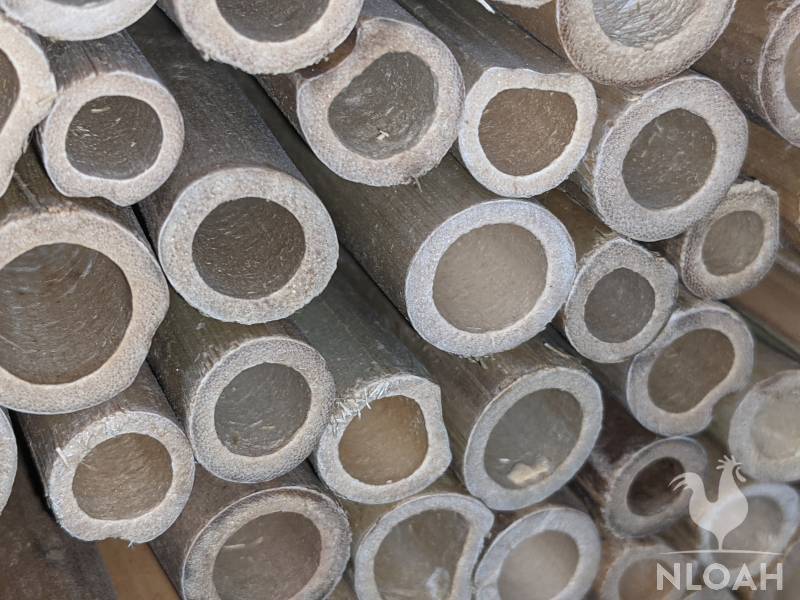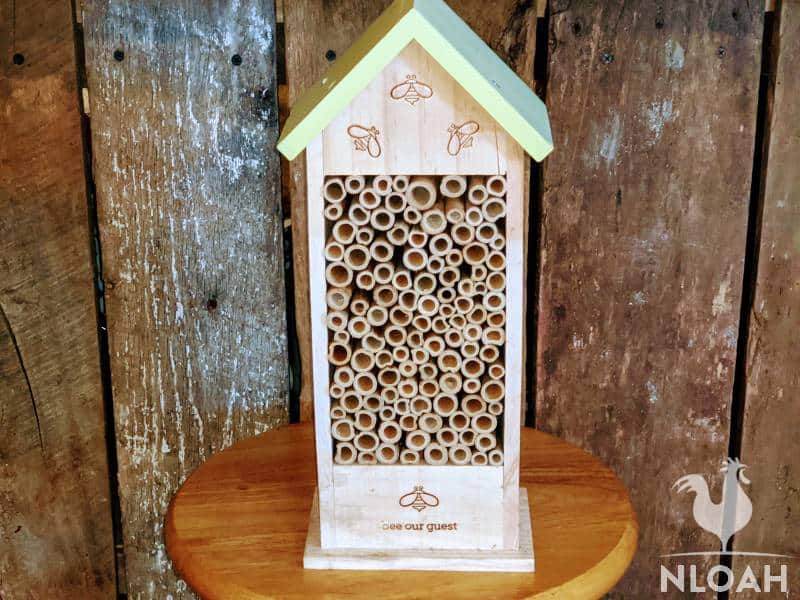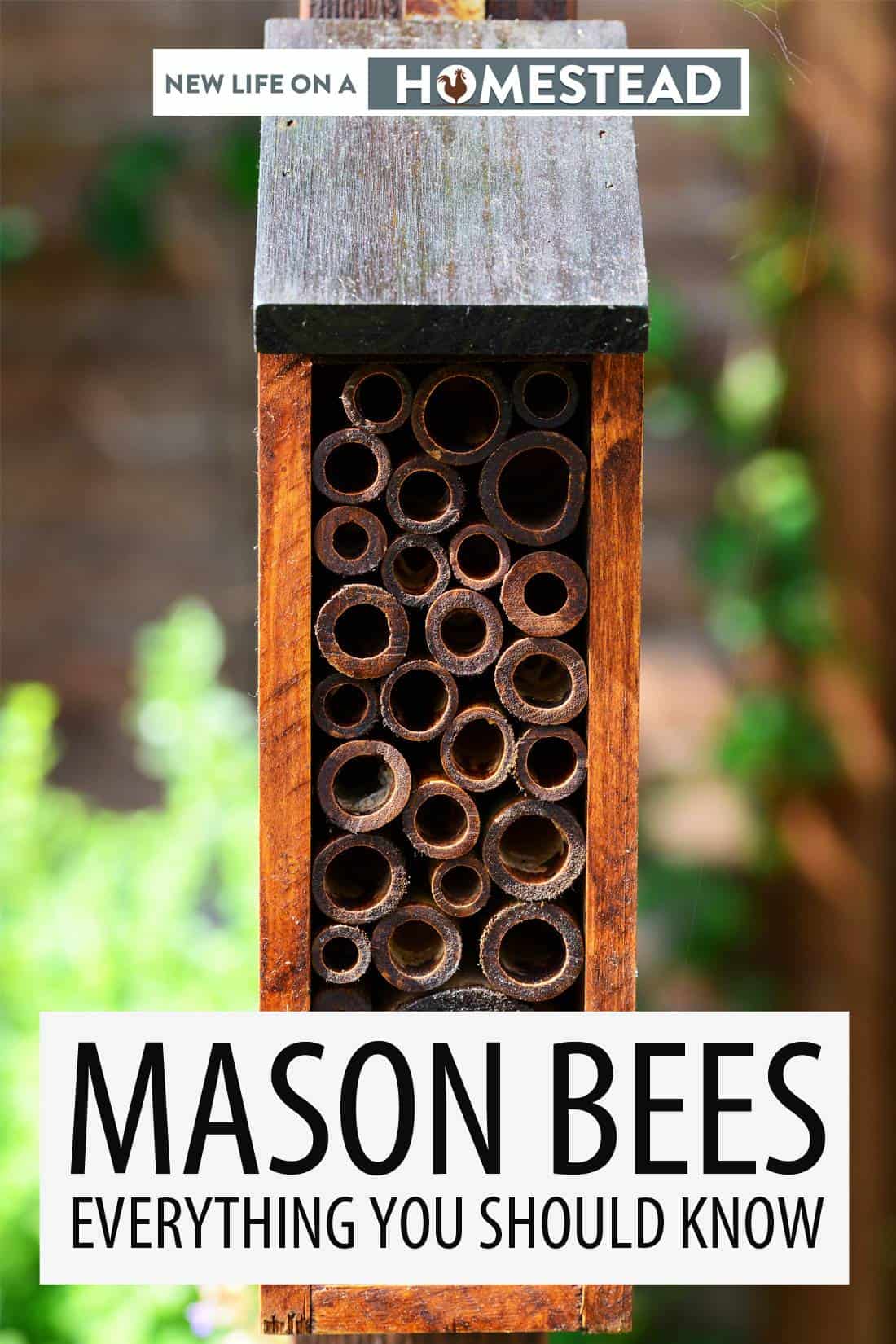Mason bees are potent little pollinators. It takes only two or three female mason bees to successfully pollinate a mature fruit tree. Yet, even with all of this pollinating ability, few people keep mason bees.
Some folks mistake these beneficial bees for destructive carpenter or masonry boring bees, and run them out of the garden entirely.

They are not immediately recognized as bees because they appear to an untrained eye to more closely resemble large flies. Mason bees come in a variety of shades, including a dark hue blue or shading similar to that of honey bees and bumble bees.
Where Do Mason Bees Live?
Mason bees are found throughout the United States and North America. America. The Osmia lignaria variety of mason bee is the most commonly found in America. It is more commonly referred to as either the “orchard” or “blue orchard” mason bee.
6 Mason Bee Varieties Found Around The Globe:
- Osmia lignaria
- Eastern Snail Shell Mason Bee
- Hornfaced Mason Bee
- Maine Blueberry Mason Bee
- Red Mason Bee
- European Orchard Mason Bee

Mason Bee And Honey Bee Differences
The mason bee is a solitary pollinator. Unlike both honey bees and bumblebees, mason bees not only do not build hives, but they also do not have a queen. This variety of bee produces neither honey, nor beeswax.
They may not make hives like honey bees, but still need to find a place to call home. Mason bees look for a hole or tunnel that has been bored out previously by beetles or other insects when looking for a place to nest and make a home.
It would be incredibly rare for a person to get stung by a mason bee. They are curious bees, and will fly very close to humans – sometimes in large groups.
A mason bee will land on you and walk about, much like a fly. Unless you accidentally pinch or grasp onto a mason bee, the likelihood of being stung is substantailly remote.
In the rare event that you are stung by a mason bee, you probably will not even be sure the little insect even attacked your flesh. A mason bee sting feels like a tiny pinch, and has a lot less potency than the sting of a honey bee or bumble bee.
After being stung by a mason bee, expect to see a white welt, slightly raised and measuring about a quarter of an inch in diamater, appear on your skin. A red patch that is about two inches long may also accompany the welt.
Mason bees are also exceptionally hardy against the Varoa mites that have wreaked havoc on honey bee populations around the world.
These pollinators will not mate with the highly aggressive African bees that may be infiltrating honey bee populations in the United States.
As amazing as mason bees are at pollinating, it would be a huge misconception to believe they can replace honey bees on the homestead.
They are excellent for spring pollination in orchards and early harvest crops, but there will simply not typically be enough mature mason bees avialable to pollinate traditional garden crops as they bloom through late summer into the harvest.
The honeybee colony system churns out a fairly steady supply of bees throughout the year. Mason bees should be viewed as a booster to your growing efforts, and to the pollinating work completed by the honey bees.
Why Are Mason Bee Such Excellent Pollinators?
Enhanced pollination of plants is the primary reason gardeners and homesteaders are finally becoming more enamored with mason bees.
Because mason bees do not have to work diligently to support a colony while going about their daily pollinating routine, they are far more productive in their plant growth aiding efforts.
The vast majority of the pollen collected remains with the mason bees and is not shared with colony members.
The physical attributes of mason bees may also play a role in their top notch pollination abilities. They are quite hairy, and do not appear to be very concerned about sharking all of the scruff out of their hair before flying from one plant to the next.
Honeybees cleanse themselves in-between their flower route, causing up to 90 percent of the pollen to be lost back into the air.
Even during the early and chilly days of spring, mason bees are up and outdoors early. They likely get a couple of hours on pollination duty before the more cold susceptible honeybees decide it is time to fly out of the hive.
Because fruit trees and herb plants start to bloom during the early morning hours, having mason bees in the garden will almost immediately bolster their overall health and growth.
Mason Bee Life Cycle
During the early weeks of spring in March or April, mason bees will start making an appearance. Mating begins not long after these pollinators leave their nests in seach of both nectar and pollen.
Female mason bees start to look for a new home as soon as possible. She will search for a tube style structure, and once she finds one, egg laying in the back of the tube will start in rapid fashion.
The female mason bee will then deposit some nectar and pollen to use for food and then build a wall to create a protective cell around the egg.
The building of the cell walls around each individual egg laid is how these pollinators were nicknamed “mason” bees. Typically, 10 eggs will be laid from spring through June. The mature female mason bees start dying off after the egg laying process has completed.
At this same time, the eggs are starting to hatch and feed off of the food their momma left for them. The larcae go through their entire life cycle insdie the nursery cell – molting four to five times.
Come August, the larvae spin a cocoon and slowly complete the process of developing into a mature mason bee.
How To Attract Mason Bees
You can purchase mason bees, but attracting them naturally to your garden is far more highly recommended. The mason bees already living in the area are better hardened off to that particular climate as well as any mites or similar parasites that could negatively impact their nesting habits.
You can attract mason bees by providing nesting tunnels (purchased or homemaade) and ensuring there is a plentiful food source along with mud, close to the house you hope they will choose to occupy.
The mason bee tunnels shown below are part of a commercially manufacted “hotel” for the pollinators to live in. They seem to be made out of a hard and woven type of cardboad, similar to cardboard dowels inside of wrapping paper and posters – but firmer:

You can use thick paper straws or hollowed reeds placed tightly together inside of a tin can to make a mason bee house.
Drilling about 15 to 20 holes (5/16 of an inch wide in diameter) into wood fence posts to attract mason bees. The holes should be about six inches long and not be drilled all the way through the wood post – to create tunnels for mason bee nesting.
If you do not want to build a cute house shaped frame to house tunnels for the mason bees, yet still want to attract them to your property, simply follow the hold drilling tips above and using a scrap block of untreated lumber.
Bees of all types love vibrant colors. Painting the frame of the bee house may help attract mason bees to come and relocate in the new dwelling, as well.
Plants That Attract Mason Bees
| Asters | Black Eyed Susans |
| Bee Balm | Zinnias |
| Raspberries | Purple Cone Flowers |
| Cherry Trees | Apple Trees |
| Lilac Bushes | Anise Hyssop |
| Mountain Mint | Sunflowers |
| White Clover |
Building a mason bee home can be simple, cheap, and not even require the use of power tools. Check out this video for a DIY mason bee house you can complete in an hour or less:
Mason Bee House Maintenance Tips
There are two different schools of thought on mason bee maintenance. One involves leaving the house entirely alone, and allowing the bees to naturally clean out the used tunnels – or consider the structures a one-time use project.
The second view is more focused on cleaning out the tunnels as carefully and naturally as possible to avoid damanging of the mason bee eggs that will be laid inside.
Keeping the mason bee house clean may remove or prevent bees pest, bee carcas parts from larvae that failed to thrive, and disease from harming future inhabitants.
You can also rotate or remove the tubes in a hotel before spring each to give a nice clean new nesting area without spending time cleaning out used ones.
Using a half a cup of bleach per gallon of water or a 4 to 1 ratio of water to bleach is the generally accepted recipe for mason bee tunnel or tube cleaning.
You can clean out wood blocks used to house the mason bees with the same bleach water and pipe cleaner method, but must fill and dump the wood blocks about five to 10 times before setting them upside down to dry out for a day or two before setting them back up for use.
Check on the mason bee blocks, homes, or hotels throughout the spirng and summer for signs of an ant infestation or mud/leaf capping on the tunnels/tubes. Any signs of capping could indicate a leafcutter infestation.
Upon noticing signs of parasite infestation, immediately clean or remove and pitch the infected tubes.
Placing filled mason bee tubes in a mesh bag during the summer to limit the larvae exposurre to parasites, birds looking for a meal, or times of intense heat is also a practice some mason bee “keepers” engage in.
But, these are hardy bees and I have personally found it best just to leave healthy and filled tunnels alone and permit the larvae to hatch naturally.
The bees will avoid sharp or prickly locations and refuse to build their nests in such a spot. Checking to make sure the weather has not caused any flaking inside the tunnels will help prevent rough edges from deterring the bees.
Placing a large paper straw inside of tunnels that have been used repeatedly will help increase their longevity as a welcoming environment for nesting.
Commonly used mason bee tunnel and tubing materials or liners include:
- Bamboo
- Reed
- Cup Plant
- Teasel
- Paper Straws
- Cardboard dowels

Mason Bees Home Location Tips
Search for a location around your garden, apothecary patch, fruit grove, or decorative landscapiping that is southern or southern facing so it garners morning sunshine. A food source should be located no further than 200 to 300 feet away.
Place a mason bee house along a fence post, structure wall, or similar sturdy item to prevent the house from swaying in or overly exposing it to wind.
Mason bees are excellent fliers, and prefer not to be too close to the ground when making a nest for eggs. Placing a mason bee house at chest or shoulder height is recommended.
Making space on your homestead for mason bees may help achieve a decidedly robust fruit grove and herb harvest yield.
Even if you are keeping honey bees and are limited on space, as long as there is enough early spring through early fall food available, allowing both types of bees onto the homestead could put a lot more homegrown natural food onto the table all winter long.


Tara lives on a 56 acres farm in the Appalachian Mountains, where she faces homesteading and farming challenges every single day, raising chickens, goats, horses, and tons of vegetables. She’s an expert in all sorts of homesteading skills such as hide tanning, doll making, tree tapping, and many more.
